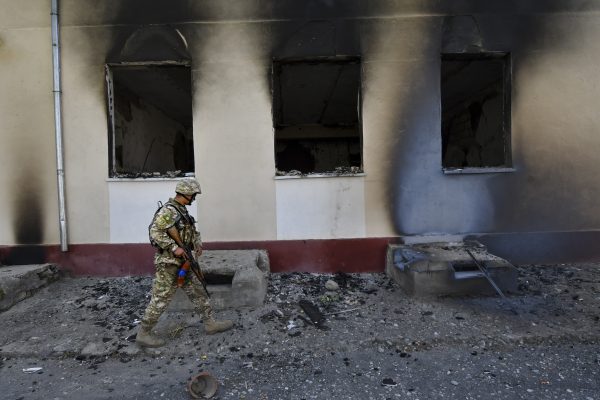
Following the dramatic escalation of violence on the Kyrgyz-Tajik border earlier this month, the heads of the Kyrgyz and Tajik security services signed a protocol on September 25 under which four border posts in each side of the contested border would be vacated. It’s an effort at de-escalation, but one shadowed by the ongoing trade of bitter accusations of blame, discontent among citizens, and a lack of both clarity and trust.
The protocol reportedly agreed upon on September 25 between Chairman of the Kyrgyz State Committee for National Security Kamchybek Tashiev and the head of Tajikistan’s State Committee for National Security Saimumin Yatimov has both sides vacating four border posts apiece: the Tamdyk, Bulak-Bashi, Katta-Tuz, and Ak-Sai checkpoints in Kyrgyzstan, and the Bedak, Kekh, Karakchikum, and Sharshara border posts in Tajikistan. Both sides agreed to not deploy forces to the named border posts and instead institute mobile border patrols along agreed-upon routes.
As RFE/RL’s Tajik Service noted, the Tajik government did not comment on the details of the agreement reached with Kyrgyzstan. Officials from Sughd region in Tajikistan said that the meeting of border officials concerned the removal of heavy equipment from the border.
On the Kyrgyz side, some have expressed concerns that the closing of border posts — those named are largely around the Tajik exclave of Vorukh — will allow the exclave to expand into Kyrgyz territory unchallenged. In Batken on September 28 around 100 people gathered near a regional administrative building seeking clarification on the reported agreement; others demanded the protocol be canceled. In Bishkek, members of parliament called for the creation of a commission to study the protocol, noting that it may have been signed but it has not been ratified by the parliament. One parliamentary deputy, Sultanbay Aizhigitov, echoed concerns about the protocol de facto ceding the Kyrgyz territory between Vorukh and the Tajik mainland. Others have called for Tashiev to resign, blaming his previous “populist statements” regarding the border and a lack of transparency for the latest escalation of violence, saying it “provoked an attack by the armed forces of a neighboring state.”
In response to such criticism, Kyrgyz President Sadyr Japarov reportedly suggested “collecting” anyone who spreads “false information” regarding the border and sending them to serve on the border until it is delimited and demarcated.
A presidential spokesman tried to explain that the two sides closed outposts near each other that were sources of tension. “There is constant shooting due to minor reasons, which sometimes leads to major conflicts,” presidential press secretary Erbol Sultanbayev said in a Facebook post.
Neither side has released the text of the apparently agreed-upon protocol, which makes for murky understanding and generates a ripe space for mis- and dis-information. (Update: After this article was published, the Kyrgyz did release the text of the protocol.)
Meanwhile, on September 26 residents of Somoniyon, a Tajik village, reported the explosion of three mortar shells fired from Kyrgyzstan — neither the Tajik nor Kyrgyz authorities commented on the alleged shelling.
Kyrgyzstan reported 62 citizens died in the recent conflict, and Tajikistan reported 41 dead (though RFE/RL’s Tajik Service published a list of 74 Tajik citizens killed in the recent violence.) Hundreds on both sides were injured and thousands displaced, as many as 140,000 reported displaced on the Kyrgyz side. Both sides can point to damaged civilian infrastructure, from homes to businesses to schools, underscoring the serious toll the respective governments’ inability to reach an agreement regarding the border has taken. Over the years, the border has become increasingly militarized, with both countries acquiring and positioning new weapons and forces ever closer to disputed territory.
Last week at the U.N. General Assembly, Kyrgyzstan and Tajikistan laid their respective cases out for an international audience. Japarov, in his September 20 remarks, accused Tajikistan of violating the Alma-Ata Declaration of 1991, “which calls for recognizing and respecting each other’s territorial integrity” and laid clear blame for the outbreak of violence in April 2021 and September 2022 on Dushanbe. Speaking for Tajikistan on September 24, Foreign Minister Sirodjiddin Muhriddin accused Kyrgyzstan of disregarding relevant agreements and “ creating a false appearance of withdrawing troops and heavy military equipment from the line of contact by hiding them in populated areas near the border,” according to a U.N. summary of his remarks. “The responsibility for any next round of tension on the Tajik-Kyrgyz border will lie exclusively with Kyrgyzstan,” he said.
The protocol reportedly signed on September 25 could be a starting point for de-escalation on the border, but it could also just be a temporary reprieve given the low levels of trust across the border. Contention in Kyrgyzstan’s more dynamic political space and a lack of transparency on the Tajik side could also upend any nascent de-escalation.
The Difficult Path Toward De-escalation on the Kyrgyz-Tajik Border
Source: Frappler

0 Comments